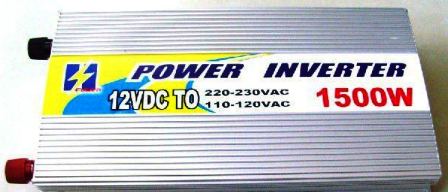Categories: Featured Articles » Autonomous power supply
Number of views: 24718
Comments on the article: 1
Inverter for home solar power station
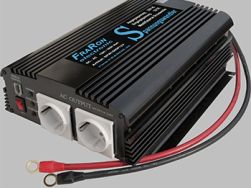 In the energy sector, it is often necessary to convert some quantities to others because electric energy is produced by sources of alternating or direct current. Corresponding consumers are created for them: electric motors, transformer devices, household appliances.
In the energy sector, it is often necessary to convert some quantities to others because electric energy is produced by sources of alternating or direct current. Corresponding consumers are created for them: electric motors, transformer devices, household appliances.
In many industries, as in alternative energy, there is a need to exploit consumers from combined sources. Rechargeable batteries are charged, and electronic devices, computer devices are fed with direct current or rectified from electric power generators with a rotating electromagnetic field.
The inverse task of the electric motors of the sinusoidal harmonics of household electric receivers from direct current sources is solved by converting electricity to variable using specially designed complex electrical structures called inverters.
Purpose and tasks of the inverter
By the method of connecting to the solar station, consumers and batteries, inverters are divided into:
-
network
-
autonomous
-
hybrid.
Network models with the designation “on grid” operate from a solar power station on the load of a public power grid. They are most used in systems with capacities exceeding 10 kW, typical for use in European countries. In Russia, the provisions of the Green Tariff do not give individuals the right to use this method.
Standalone inverters stand for “off grid”. They are connected to domestic household consumers, and powered from rechargeable batteriesrecharged by solar modules through controllers.
Hybrid designs use both connection methods. They mix well with uninterruptible power supply circuitscan through the automation of the controller work from the battery and / or solar module if necessary.
Inverter Principles
During operation, a small part of the applied energy is lost on heating the circuit elements and side processes. Therefore, the output power is always lower than expended. The efficiency of a good design is determined by the efficiency with a value of 90 - 95%.
The inverter is considered to be a generator of periodic voltage, which in shape is very close to sinusoidal harmonics or differs significantly from it in the shape of the output signal.
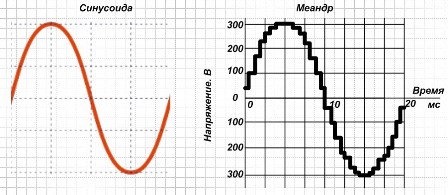
Graphs of sinusoidal oscillation and its analog produced by the inverter
The graph shows the principal views of a sinusoid and a voltage close to its type at the inverter output, which is commonly called the “Meander”. Depending on the complexity of the design with the possibilities of implementing various functions by it, the shape of the meander can be even closer to the characteristics of the sine or roughened, resembling ordinary trapezoids or even rectangles on each half-wave with their appearance.
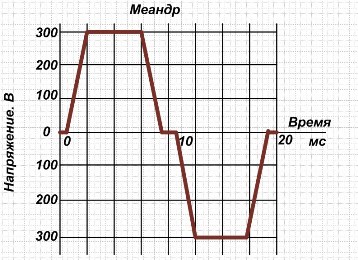
The simplified form of the meander is more suitable for devices without inductive loads consuming the active component of electrical power. It is different thermoelectric heaters (designation "TEN"), incandescent lighting systems and similar resistive structures.
The shape of the meander can have a certain effect on the devices of AC electric motors and transformer assemblies of household appliances. The ideal solution for their work is a pure sine. Therefore, complex inverters that produce an output voltage very close to sinusoidal harmonics are more attractive for equipment. But the cost of their production is higher.
The special accuracy of the meander approach to the sinusoid is important for high-precision measuring instruments, medical equipment, professional audio systems, telecommunication equipment.
Design Features
For home solar power plants in Russia, circuits that create one phase of alternating voltage with a value of 220 volts are in greatest demand.
To convert direct current, the inverter can operate according to a transformer circuit or without it. The presence of a transformer significantly complicates the design, but allows you to create a high-quality output signal.
The device’s cooling system may use a forced fan. In expensive designs, attention is paid to:
-
noiselessness
-
the use of several operating modes, depending on the load (especially when overheating).
Inverters manufactured by industry can be combined from single-phase systems into three-phase devices of increased power. They are able to perform various tasks up to the transfer of surplus generated electricity to the industrial network.
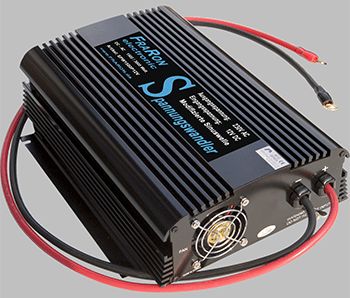
Basic rules for choosing an inverter
DC household appliances and batteries operate at standard 12/24/36/48 volts, depending on their design. Manufacturers of inverters for each specified type of voltage release their equipment. This should be analyzed when choosing a model.
When using the inverter, the following should be considered:
-
Peak power consumption
-
four phases of operation: start-up mode, stage of long-term conversion of electricity at rated power, idle, overload.
Peak power of consumers is measured at a certain point in time when creating critical loads, can significantly exceed the nominal values of a standard network ~ 220V / 50Hz.
In start-up mode, inverters are capable of delivering excessive power for a short start-up time of electric motors (several milliseconds) and commissioning of capacitive loads. This mode is characteristic when turning on refrigerators, washing machines and dishwashers.
The continuous operation mode should correspond to the nominal characteristics of the chosen design.
The power consumption of the device without an output load should not exceed 1% of the nominal value for high-quality models.
During the overload phase, certain types of inverters can reliably transmit power exceeding up to 50% of the nominal value within half an hour. But this ability is different for each model of the device.
Determining the magnitude of the ideal load is very problematic. Therefore, inverters are selected with the creation of a power reserve with a margin of up to 20% of the calculated values.
In an extensive home network, the load can constantly fluctuate over a wide range of values. With this nature, it is recommended to purchase not one powerful inverter, but to calculate the optimal number of steps of used capacities for the acquisition of several models, alternately switched by an automation circuit for an economical, optimal use of equipment resources.
The presence of built-in protections characterizes the quality of the inverter, which should be taken out of operation when:
-
deviation of the supply voltage at the upper and lower levels,
-
short circuits in the output circuit,
-
overloads in current and temperature.
In cases of reducing the load to the minimum values, the automation circuit can put the inverter in standby mode. But this function is not inherent in all models.
Strength and reliability of mechanical construction
The choice of installation location of the inverter is influenced by the quality of manufacture of its housing. For open air conditions, sealed models are used, classified by the IP65 index (short for Ingress Protection Rating), a system for analyzing the degree of protection of electrical equipment housings from ingress of water and particulate matter according to international standards.It tolerates harsh operating conditions in all weather conditions.
The quality of installation and loading and unloading operations is affected by the configuration of the hull and the completeness of the components supplied together with the main equipment.
Circuit mounting recommendations
At first, it is recommended to connect all consumers to the output circuits of the inverter, only then engage in switching power supply circuits.
When idling, batteries and solar modules have more than 20 V, which will cause high voltage to electrolytic capacitors. And they, in turn, during manipulations in the output circuits will begin to discharge pulse.
Continuation of the article:How to install and operate solar panels
See also at i.electricianexp.com
:

